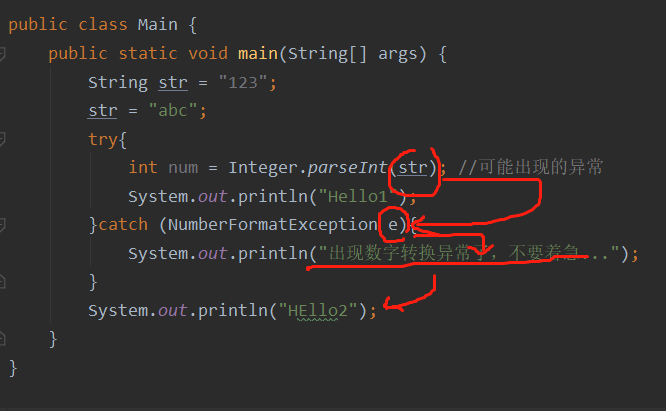异常
Error编译时发生
Exception运行时发生
其他因变成错误或偶然的外在因素导致的一般性问题,可以使用针对性的代码处理
需要在编写程序时就考虑到错误检测,错误信息提示,错误处理
有的错误只有在运行时发生,比如:除数为0,数组下标越界
异常体结构
空指针异常
import org.junit.Test;public class Main {//空指针异常@Testpublic void test1(){int[] arr = null;System.out.println(arr[0]);}}
数组角标越界
import org.junit.Test;
public class Main {
//数组角标越界
@Test
public void test1(){
int[] arr = new int[10];
System.out.println(arr[10]);
}
}

import org.junit.Test;
public class Main {
//字符串角标越界
@Test
public void test1(){
String str = "abc";
System.out.println(str.charAt(4));
}
}
//java.lang.StringIndexOutOfBoundsException: String index out of range: 4
java.lang.StringIndexOutOfBoundsException: String index out of range: 4
类型转换异常
import org.junit.Test;
import java.util.Date;
public class Main {
//类型转换异常ClassCastException
@Test
public void test1(){
Object obj = new Date();
String str = (String)obj;
}
}
数字格式化异常
public class Main {
//类型转换异常NumberFormatException
@Test
public void test1(){
String str = "123";
str = "abc";
int num = Integer.parseInt(str);
}
}
输入异常
public class Main {
public static void main(String[] args) {
//类型转换异常InputMismatchException
Scanner scanner = new Scanner(System.in);
int score = scanner.nextInt();
System.out.println(score);
}
}
算数异常
//算数异常ArithmeticException
int a =10;
int b = 0;
System.out.println(a/b);
异常的处理机制—抓抛模型
“抛”:程序正在执行的过程中,一但出现异常,就会在异常代码处生成一个对应异常类的对象,并将此对象抛出,一旦抛出对象,其后代码不再执行
“抓”:异常处理方式
try-catch-finally
try{
//可能出现异常的代码
}catch(异常类型1 变量名1){
//异常处理的方式1
}catch(异常类型2 变量名2){
//异常处理的方式2
}catch(异常类型3 变量名3){
//异常处理的方式3
}
……
finally{
//一定会执行的代码
}
**
- finally 可选择使用
- 使用try将可能出现异常代码包装起来,在执行过程中一旦出现异常就会生成一个对应异常类的对象,根据此对象的类型,去catch中进行匹配
```java
public class Main {
public static void main(String[] args) {
} }String str = "123"; str = "abc"; try{ int num = Integer.parseInt(str); //可能出现的异常 System.out.println("Hello1"); }catch (NumberFormatException e){ System.out.println("出现数字转换异常了,不要着急..."); } System.out.println("HEllo2");
结果: 出现数字转换异常了,不要着急… HEllo2

```java
public class Main {
public static void main(String[] args) {
String str = "123";
str = "abc";
try{
int num = Integer.parseInt(str); //可能出现的异常
System.out.println("Hello1");
}catch (NullPointerException e){ //开错药了,没吃,str根本没进去
System.out.println("出现数字转换异常了,不要着急...");
}
System.out.println("HEllo2");
}
}
Exception in thread "main" java.lang.NumberFormatException: For input string: "abc"
catch 内的 异常处理 编写错误,则异常根本进不去catch,相当于没处理
- 一旦try中的异常对象匹配到某一个catch,就进入catch中进行异常的处理,一旦处理完成,就跳出当前try-catch结构(没写finally情况),继续执行其后代码。
```java
public class Main {
public static void main(String[] args) {
} }String str = "123"; str = "abc"; try{ int num = Integer.parseInt(str); //可能出现的异常 System.out.println("Hello1"); }catch (NullPointerException e){ //开错药了,没吃,str根本没进去 System.out.println("出现空指针异常了,不要着急..."); }catch(NumberFormatException e){ System.out.println("出现数据转换异常"); } System.out.println("HEllo2");
结果 出现数据转换异常 HEllo2 ```
- catch中的异常类型如果没有子父类关系,则谁声明在上下无所谓
异常处理方式常调方法
getMessage()
System.out.println(e.getMessage);
printStackTrace()
体会
- 使用try处理编译异常,使得程序在编译时就不再报错,但是运行时仍可能报错。相当于在我们使用try将一个编译时可能出现的异常延迟到运行时出现
- 开发时,由于运行时异常比较常见,所以我们通常就不针对运行时异常编写try-catch-finally
throws+异常处理
- 写在方法的声明处,指明此方法执行时,可能会抛出的异常类型
一旦当方法体执行时,出现异常,仍会在异常代码处生成一个异常类的对象,此对象满足throws后的异常类 型时就会被抛出。异常代码后续的代码就不再执行
- try-catch-finally:真正的将异常处理掉
throws的方式只是将异常抛给了调用者,并没有真正将异常处理掉









